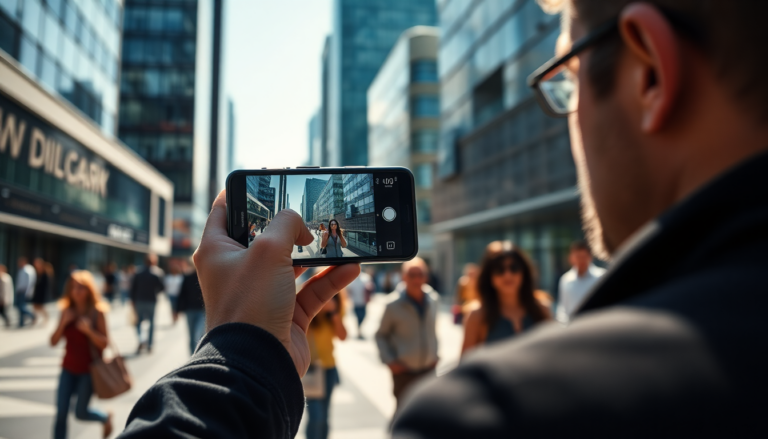Argomenti trattati
Imagine shooting a video on your smartphone, but instead of the usual shaky footage, you get smooth, cinematic quality. That’s the magic of Optical Image Stabilization (OIS). Whether you’re capturing moments for YouTube, Instagram, or just for fun, OIS can elevate your video quality dramatically. The technology has evolved to become a staple in many high-end smartphones, and in 2025, it’s more impressive than ever. Let’s dive into how OIS works and which smartphones are leading the charge.
Understanding optical image stabilization
At its core, Optical Image Stabilization is designed to counteract the subtle movements of your hand while filming. So, if you’ve ever found yourself frustrated with blurry videos or photos, OIS is here to help. Using a combination of gyroscopes and mechanical adjustments, OIS detects movement and compensates for it in real-time. It’s quite fascinating, really. When you tilt your smartphone, the gyroscope senses this motion and shifts the camera’s lens accordingly, keeping your shots steady. I remember the first time I used a smartphone equipped with OIS; the difference in video quality was like night and day. It was almost as if I had a professional camera in my pocket.
The mechanics behind OIS
So, how does this all work? The gyroscope is the unsung hero here. It tracks the phone’s orientation in three dimensions—yaw, pitch, and roll—and sends this data to a microcontroller. This tiny device calculates how the lens or sensor needs to adjust to counteract any detected movement. It’s a bit like having a miniaturized camera crew working tirelessly behind the scenes to ensure your footage looks pristine. There are various types of OIS systems out there; some shift the lens while others move the sensor. Regardless of the method, the goal remains the same: smooth, stable videos.
Types of image stabilization
When it comes to smartphone cameras, image stabilization isn’t a one-size-fits-all solution. There are three primary types of stabilization: Optical Image Stabilization (OIS), Electronic Image Stabilization (EIS), and Hybrid stabilization. OIS, as we’ve discussed, relies on physical movements of the lens or sensor. EIS, on the other hand, uses software algorithms to analyze video frames and crop the footage slightly to counteract any shake. Hybrid stabilization combines both methods, providing an even more robust solution for video capture.
For those who enjoy shooting in less-than-ideal lighting conditions, OIS shines. It helps capture clearer images by minimizing the effects of slight movements, especially when the shutter speed is slower due to low light. However, it’s essential to understand its limitations. OIS excels in stabilizing minor shakes, but it cannot prevent the effects of significant camera movements. If you’re planning to film action-packed scenes while running, you might still want to consider using a gimbal or a tripod.
Spotlight on 2025’s top smartphones with OIS
As we step into 2025, several smartphones are making waves with their impressive OIS capabilities. One of the standout devices is the OnePlus 10 Pro, which boasts a Snapdragon 8 Gen 1 processor and a robust 50MP camera equipped with OIS. Not only does it deliver sharp images, but its performance in low-light conditions is also commendable. When I took it for a spin during an evening event, I was blown away by how well it handled the dim lighting without introducing much noise. The night mode truly felt like a game changer.
On the other hand, the Sony Xperia 1 II is a dream for photography enthusiasts. Developed alongside Sony’s DSLR team, its camera system features real-time autofocus and a plethora of manual controls. I recall a trip to the wildlife park where the Eye AF tracking was a lifesaver. Capturing fast-moving animals in focus felt like a breeze, and the OIS ensured the footage remained steady. This smartphone is perfect for those who want to blend the advantages of a smartphone with professional camera features.
Why OIS matters for your videos
In a world where content is king, having high-quality video can set you apart. Whether you’re vlogging, capturing memories, or creating marketing content, OIS can enhance your storytelling. It allows you to focus on your subject without worrying about stabilization issues. Personally, I believe that the most powerful tool we have as creators is the ability to tell a story through our visuals, and OIS is a vital part of that narrative.
When shooting video, consider the environment. If you’re filming in windy conditions or during an event where you’re moving around, OIS will help maintain a professional-level quality. Think about it: what’s the point of capturing a moment if it’s shaky or unfocused? With OIS, you can confidently share your videos, knowing they’ll look polished.
Final thoughts on using OIS
As we wrap up, it’s crucial to remember that while OIS is a fantastic feature, it’s not a magic solution. Understanding when and how to use it effectively can make all the difference. If you’re using a tripod, for instance, turning off OIS can save battery life and prevent any unnecessary processing. Also, keep in mind that not all smartphones are created equal. Some models provide superior OIS performance than others, so doing your research before making a purchase is wise.
In conclusion, embracing the power of Optical Image Stabilization in your smartphone can transform your video experience. As technology progresses, we can expect even more advancements in this space. So, whether you’re a casual user or a budding filmmaker, investing in a device with robust OIS could be one of the best decisions you make this year. Who knows? Your next viral video could be just a steady shot away!

